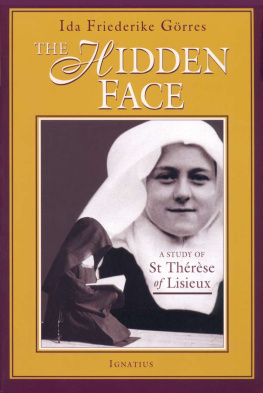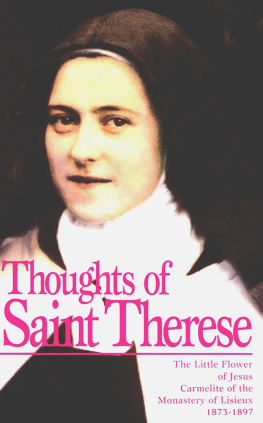THE HIDDEN FACE

ST THRSE OF LISIEUX
A photograph taken in June 1897, three months before her death
THE HIDDEN FACE
A Study of
St Thrse of Lisieux
by
IDA FRIEDERIKE GRRES
IGNATIUS PRESS SAN FRANCISCO
Originally published as Das Senfkorn von Lisieux
8th revised edition of Das verborgene Antlitz:
Eine Studie ber Thrse von Lisieux
Herder Verlag, Freiburg im Breisgau
1959 by Ida Friederike Grres
Published with ecclesiastical approval
English edition translated by Richard and Clara Winston
Pantheon, New York
Cover art: Carmelite Kneeling and Reading a Book
Hulton-Deutsch Collection / CORBIS
Cover design by Riz Boncan Marsella
Published by Ignatius Press, San Francisco, 2003
ISBN 978-0-89870-927-8
Library of Congress catalogue number 2002113184
Printed in the United States of America
Dedicated to
Esther von Kirchbach
in friendship
CONTENTS
I
THE STORY AND THE PROBLEM
I. THE ASCENT
T HE CULT of St Thrse of Lisieux has a history unequalled in recent centuries. This young nun, who was born in 1873 and entered a convent at fifteen, died at twenty-four of galloping consumption. Never, in this short span of life, did she do anything that struck her contemporaries as extraordinary, anything that even attracted attention. The general estimate of her among the nuns of the convent community, with whom she had lived in close association for nine years, is expressed in a well-known anecdote: from the window of her sickroom Thrse, during the last months of her suffering, heard one nun say to another: Sister Thrse will die soon; what will our Mother Prioress be able to write in her obituary notice? She entered our convent, lived and diedthere really is no more to say.
Yet it was this very obituary noticeone of an unusual sort, as it turned outwhich after only a few months begot an incredible storm of spontaneous veneration. It began on a timid note, like a plucked string, and swelled to a thousand-voiced chorus extending over whole countries and continentslong before the authorities approved of these demonstrations. As early as 1909had she lived, Thrse would then have been thirty-six years oldveneration of her was so widespread, and so many urgent petitions had been submitted to Rome pleading for a decisive pronouncement, that steps towards her solemn beatification were initiated. This was a breach of the express convention of canon law that no such procedure should be undertaken less than fifty years after the death of a believer. We must hurry to raise the little saint to the altars, said Cardinal Vico, Prefect of the Sacred Congregation of Rites, which is in charge of such matters, otherwise we shall be anticipated by the voice of the people. It was popular demand on the part of Catholic Christendom which was fulfilled, in the years 1923 and 1925, by Pope Pius Xls beatification and canonization of little Thrse.
The two roots of this strange religious movement, which is without its counterpart in recent Church history, are a book and a mass experiencing of miraculous aid, the so-called shower of roses.
The book was the above-mentioned obituary notice. Deviating from the custom of the Carmel, the Prioress allowed the deceased nun to speak for herself. She published two notebooks that Sister Thrse had written during her last two years for her elder sisters, nuns in the same convent. These contained childhood memories, girlhood experiences, a letter, and finally, at her Superiors request, some practical lessons on convent life.
Sent out to the convents of the Order under the title of The Story of a Soul , it was a fairly large volume as compared with the modest proportions of the usual obituary notices. Its effect outran the wildest expectations. Within a very short time, the existing copies had been lent out by the various convents, at first to relatives, priests and devout souls; all over the world readers began demanding new editions. The books public swelled like an avalanche; between 1898 and 1932 the autobiography was in constant demand, and 700,675 copies were circulated, while the abridged popular edition ran to almost two-and-a-half million copies in the original language alone. Up to Thrses canonisation the book had been translated into thirty-five languages.
The book contained the young nuns proclamation: After my death I will let fall a shower of roses. The phrase derived from the life of one of the saints, read aloud at table in the convent, in which a sick man sees roses fall upon his bed as a sign that his prayers have been heard.
Was it this uncommonly bold promise, or was it the total impression of the autobiography, that aroused such confidence? In any case, thousands of hands stretched out to receive the promised shower of roses. It fell and has not ceased to fall.
In the year 1909, twelve years after her death, an average of fifty letters daily were pouring in, gratefully and jubilantly relating prayers that had been heard. These were faithfully collected, and the most striking events, conversions and cures were published in volumes under the title of Pluie de Roses . By 1925 the collection contained three thousand closely printed pages. One has a curious sensation leafing through these badly printed volumes, cheap in their format, virtual museum-pieces of tasteless book-making. On the frontispiece of the last issue, 1923-25, the saint is shown in sentimental pose, eyes raised to Heaven, surrounded by cherubs in the devotional style of 1900. Underneath are the simple words: I shall come back to the earth to teach others to love Love. Then, in 608 pages, follow 427 accounts: two-thirds of them concerning miraculous cures, the rest narrating conversions, succour in the midst of dangers, accidents, and so forth. The stories of cures generally have appendedto them affidavits by the doctors and nurses in charge of the patients, and by other eyewitnesses. We read of cancer of various organs, blindness, tuberculosis in its last stages, gastric ulcers, meningitis, and many other severe illnesses, of cures of very small children in whom imagination and suggestibility could play no part. We find reports of conversions of unbelieving and apostate Catholics who had lived for twenty, forty and sixty years on a hostile footing with the Church; reports of spiritual illumination, of peace descending upon tormented, struggling persons, of Christians of other denominations coming to the Church. A special section is devoted to the shower of roses in missionary countries. Here are reported cures, conversions, rescues from imprisonment, plagues, and floods in Peking and Tientsin, in tiny towns in the Chinese provinces, among Mohammedan Arabs in Tunis, in India and Madagascar, in South Africa and the Equatorial regions, Dahomey, Nyasaland, in the Canadian Lakes region, Manchuria and the Solomon Islands, Alaska and Siamfrom all places where missionaries and their parishes, and even pagans, trustfully called upon the little saint.
Since 1926 the journal Les Annales de Ste Thrse de Lisieux has continued the chronicle of the shower of roses and the account of the veneration of Thrse throughout the world. These constitute remarkable documents in the history and psychology of religion. The testimony is overwhelming. In the face of the stories and affidavits, one would have to assume a worldwide conspiracy of persistent and shameless liars if one wished to challenge wholesale the credibility of these plain, grateful accounts. It may be that some experiences were only felt to be miracles by the persons concerned; but the quantity of sheer inexplicable events far outweighs such dubious cases.
Next page













